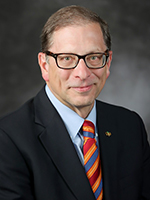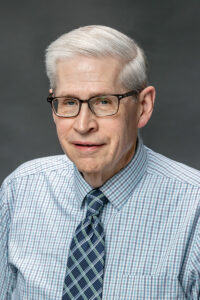Homegrown healthcare for North Dakota
Dr. Joshua Wynne, UND School of Medicine & Health Sciences dean, briefs legislative committee on school’s contributions to state

Over the past 10 years, the UND School of Medicine & Health Sciences (SMHS) has enjoyed great success in attracting and retaining North Dakotans who graduate and remain in the state to practice healthcare.
As of 2020, statistics from the Association of American Medical Colleges Missions Management Tool show, UND’s medical school ranks in the 99th percentile of graduates practicing in rural areas and graduates entering family medicine. It’s in the 100th percentile of graduates who are American Indian or Alaska native.

During his testimony before the North Dakota Senate Appropriations Committee last week, Dr. Joshua Wynne, SMHS Dean and UND Vice President for Health Affairs, briefed legislators on the school’s efforts to attract North Dakotans and keep them in the state through North Dakota’s Healthcare Workforce Initiative. He noted that healthcare workforce shortages in U.S. rural areas date back to the early 1900s.
“One of the impressive things in North Dakota is that we actually have been working on this issue, and thus are making some progress on it over the years,” Wynne said. “One of the things that we’re obviously focused on is the healthcare workforce and trying to really ensure an adequate supply throughout the state – especially in rural areas.”
For example, in 2013, UND was in the top 25th percentile of medical schools keeping its graduates practicing in state.
“The most recent data shows UND as being at over the 67 percentile, which means that we’re doing better than two-thirds of the medical schools in the U.S.,” Wynne said.
“Part of our strategy is that if you go to the UND School of Medicine & Health Sciences, and you do a residency in state, there’s almost a 70 percent chance that you will be practicing here long term,” he explained.
Currently, UND attracts better than 90 percent of the North Dakota students who attend medical school in a given year, which is up from 67 percent in 2007. In the school’s current class, 86 percent of the student body is either from North Dakota or has strong ties to North Dakota.

Wynne noted that in in the past year, applications to UND’s medical student program are up more than 40 percent.
“I think that’s a testament to both the students’ desire to make a difference during the pandemic, as well as the attractiveness of UND as a destination,” he said. “In fact, UND is tied for the second highest retention rate in the entire United States. So we’re really attractive to our own, and we are growing our own.”
Another reason UND attracts an increasing number of applicants is the cost to attend, which Wynne said is in the 10th percentile nationally. This means 90 percent of medical school in the U.S. cost more to attend.
“This is obviously due to a number of factors,” Wynne stated. “One is clearly the generous state support we get through the Legislature.
“A second one is that we are what we call a community-based school, where we rely on doctors in the community to teach a lot of our medical students,” he continued. “So we don’t have to hire as many faculty as other medical schools. A third factor is the generous gifts from donors that provide scholarship support to students.”

Wynne also noted that over the past five years, the number of students graduating SMHS with a degree in its major programs matches the 94 percent national average. All of these statistics add up to UND’s SMHS and its programs providing value to the citizens of North Dakota.
“If you look overall, we helped provide about half of the healthcare professionals in the state,” Wynne said. “Nearly three-quarters of the family medicine physicians in the state either went to the UND School of Medicine & Health Sciences or did a residency in the state. Our impact goal is focused on education, but it obviously extends beyond that.”

David Molmen, Altru Health System CEO and chair of the UND SMHS Advisory Council, summed up Wynne’s testimony by saying: “I think you can agree that judging from the results Dr. Wynne has shared with you, it could be safely concluded that the Healthcare Workforce Initiative has been extraordinarily successful by nearly any measure.
“Virtually every strategy has born fruit, and the investment the Legislature has generously provided has yielded manifold returns to the people of our state,” he added.
Molmen requested that the Legislature continue its successful implementation of the Healthcare Workforce Initiative by providing the necessary funding to the UND SMHS so that it can do even more by expanding the school’s residency programs.



